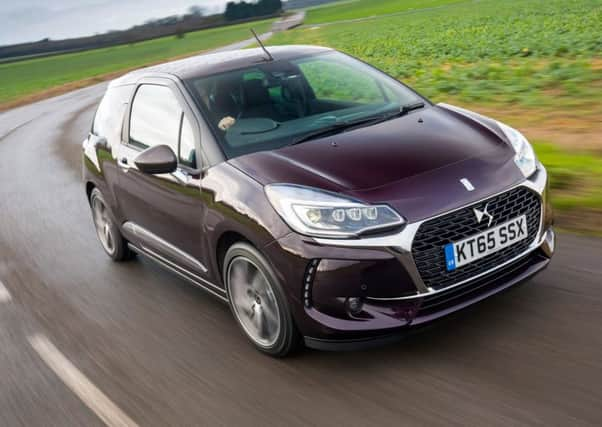Review: Citroën's redesigned DS3 range retain its true French chic


The DS3 was launched in 2010 badged as a Citroën DS3 and got instant applause for its quality. World sales are around 400,000, with one in four coming to Britain – making us the biggest buyer.
It is fair to say it really did lift Citroën up a rung in feel and finesse while retaining the marque’s quirky, cliquey heritage. Later DSA models the DS4 and DS5 have not impressed as much.
Advertisement
Hide AdAdvertisement
Hide AdIn the new DS3 range, prices start at £13,995 for the hatch in Chic specification and £16,295 for the Cabrio, each with an 82 horsepower 1.2 three-cylinder petrol engine. Versions with sub 110g C02 ratings start at £15,895 and £18,195 for the 100hp diesel in hatch and Cabrio bodies. The Performance versions have a 210hp 1.6 petrol turbo, priced from £20,495 and £22,795 and have a 125g C02 rating.
Chic trim brings alloys, air conditioning and a touch screen, with parking sensors and darker back windows for the Cabrio. Other specs are Elegance, Prestige, Ultra Prestige and at the summit, Performance Black.
My Cabrio test car was the Prestige with the BlueHDI 120hp 1.6 diesel, and a basic on the road price of £21,795. The powered roof slides back to any position you choose, stopping when it reaches the back window. Or you can keep it going, and the rear window folds away as the hood stacks up on the rump of the car. It doesn’t look pretty from outside but gives you lots of fresh air. It does mean that the boot lid will not open – but a tug on its release lever makes the hood move out of the way and the rear window fit back into place. It’s a neat bit of roof engineering. The boot access is always restricted. The aperture is the smallest I’ve seen, a mere 11 inches high and 28 inches wide. It’s a major compromise for loading large bags for Les Vacances or Le Weekly Shop. The only way to get bigger stuff in the boot is by folding down the seats but it’s a fuss.
Extras included the non- standard blue body paint with a black roof and – most useful – a rear view camera which took most of the stress out of reversing. Vision through the rear windows is not brilliant and disappears completely through the back window when the roof is fully open. Another vision robber is rain – and because of the window mechanism a wiper cannot be fitted.
As tested, with 17-inch wheels and 205/45 tyres, there was abundant road roar and plenty of bump in the suspension on poor surfaces. The tyres were Michelin Sport 3 and I suppose you sign up for a sporty drive. Dodgy roads caused some body shudder. – a consequence of its Cabrio construction. Otherwise it’s fun, fun fun. The Cabrio brings out the Jacques Tati flair the French have for imaginative cars. Its nominal precursor, the Citroën Pluriel, could be dismantled from the top down, to leave the car fully open. The snag was that you had to leave at home the bits you had removed so if the weather worsened you had no protection – nor security when parked.
I’m not yet fully in accord with touch-screen controls and as far as I could tell from the labyrinth of a handbook, the radio on/off switch is the volume control, using steering column buttons or a fiddly set of volume switches well down the dashboard.
The handbook suggested an adjacent button was the on/off switch but it proved to be the call button for DS Assistance. “Don’t worry, it happens all the time”, soothed the operator.